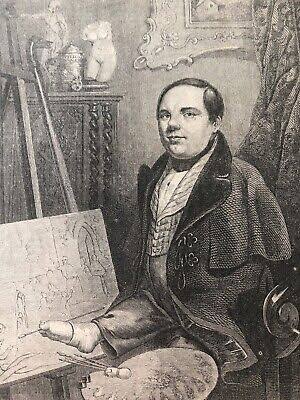Contents
Table of Contents
- Introduction: An Artist Against the Odds
- Who Was Louis Joseph César Ducornet?
- Early Life and the Challenge of Disability
- Artistic Talent and Breakthrough
- Famous Works of Ducornet
- Legacy of a Resilient Artist
- Conclusion
- FAQs about Louis Joseph César Ducornet
Introduction: An Artist Against the Odds
Imagine being born with one arm and still becoming one of the most celebrated painters of your era. That’s the story of Louis Joseph César Ducornet, a 19th-century French artist whose incredible determination and creativity made him a standout figure in art history.
Ducornet’s life and work remind us that limitations are often just stepping stones to greatness. Let’s dive into the inspiring journey of this one-armed painting prodigy.
Who Was Louis Joseph César Ducornet?
Louis Joseph César Ducornet (1806–1856) was a French painter known for his classical and religious works. Born in Lille, France, Ducornet achieved fame not only for his artistic talent but also for his ability to create masterpieces despite being born without arms.
Using his foot to paint, Ducornet defied societal expectations and proved that art knows no boundaries. His work often focused on historical and biblical themes, showcasing his deep understanding of human emotion and storytelling.
Early Life and the Challenge of Disability
Louis Ducornet’s story began on January 10, 1806, in Lille. Born with a congenital condition that left him armless, he faced significant challenges from the start. In an era with little understanding or accommodation for disabilities, his future might have seemed bleak.
However, Ducornet had a supportive family who encouraged his creativity. From a young age, he began drawing and painting using his left foot, displaying remarkable precision and control. His determination and passion for art were evident early on.
Artistic Talent and Breakthrough
Ducornet’s talent didn’t go unnoticed. He studied at the prestigious École des Beaux-Arts in Paris under the mentorship of renowned artists like François Louis Joseph Watteau.
He specialized in historical and religious paintings, gaining recognition for his ability to capture intricate details and evoke emotion. Despite his disability, Ducornet’s skill rivaled that of his peers. His unique method of painting with his foot became a testament to his resilience and genius.
Famous Works of Ducornet
Some of Ducornet’s most notable works include:
- “The Education of Achilles” – A classical masterpiece that highlights his love for historical themes.
- Religious Art – Many of his paintings depict scenes from the Bible, showcasing his ability to blend spiritual depth with artistic beauty.
- Portraits – Ducornet’s portraits reveal his keen eye for detail and his ability to capture the essence of his subjects.
Legacy of a Resilient Artist
Ducornet passed away at the young age of 50 in 1856, but his impact on the art world remains significant. He is remembered not only for his talent but also for his indomitable spirit.
His story continues to inspire artists and individuals with disabilities, proving that physical limitations cannot hinder creativity and determination. Ducornet’s life is a powerful reminder that perseverance and passion can overcome even the most daunting challenges.
Conclusion
Louis Joseph César Ducornet was more than an artist; he was a symbol of resilience and triumph over adversity. Born into a world that might have dismissed his potential, Ducornet used his unique abilities to leave a lasting mark on art history.
His works, characterized by their depth and precision, remain a testament to his extraordinary talent. In celebrating Ducornet’s legacy, we honor not just his artistic achievements but also the incredible human spirit that drove him to succeed.
FAQs about Louis Joseph César Ducornet
1. How did Ducornet paint without arms?
Ducornet used his left foot to hold and maneuver the paintbrush, demonstrating extraordinary control and precision.
2. What style of art is Ducornet known for?
Ducornet is best known for his classical and religious paintings, often featuring historical and biblical themes.
3. Where can I see Ducornet’s artwork today?
Some of his works are displayed in museums across France, particularly in Lille, his hometown.
4. What challenges did Ducornet face as an artist with a disability?
Ducornet faced societal prejudice and physical challenges, but his determination and support from his family enabled him to overcome these obstacles.
5. Why is Ducornet an important figure in art history?
Ducornet’s story exemplifies resilience and innovation, inspiring generations of artists and individuals to pursue their passions despite challenges.
Louis Joseph César Ducornet’s life proves that creativity has no limits, and his story continues to inspire dreamers everywhere.



I don’t think the title of your article matches the content lol. Just kidding, mainly because I had some doubts after reading the article.
What’s up, every time i used to check web site posts here
early in the morning, for the reason that i like to learn more
and more.
Here is my homepage :: nordvpn coupons inspiresensation
Can you be more specific about the content of your article? After reading it, I still have some doubts. Hope you can help me.
Hi, I do believe this is a great web site. I stumbledupon it ;
) I’m going to come back once again since i have bookmarked it.
Money and freedom is the best way to change, may you be rich and
continue to guide others.
My blog post … eharmony special Coupon code 2025
Hi! I’ve been following your site for some time now and finally got the courage to
go ahead and give you a shout out from Atascocita Tx!
Just wanted to tell you keep up the great work!
Feel free to visit my page vpn
Way cool! Some very valid points! I appreciate you writing this
article plus the rest of the website is very good. https://tinyurl.com/2cab6g88 gamefly 3 month free trial
This post is priceless. When can I find out more? https://tinyurl.com/2xsenm6a vpn explained
Hey there! I’ve been following your blog for a while now and finally got the
courage to go ahead and give you a shout out from Kingwood Texas!
Just wanted to tell you keep up the great job!